While working in Tasmania in the forest industry, I met many people who had competed, or were still competing, in woodchopping events. It is a popular sport, and many chopped competitively as a hobby. It originated in Tasmania and it has produced a lot of world champion axemen, so it was no surprise that many in the state competed regularly.
From October through April, competitors converge on small country shows, dedicated woodchopping festivals, and state, national and international competitions.
Across Tasmania – from Launceston to Cygnet, Ulverstone to Ross – woodchoppers take their axes to the arena, bringing with them the echoes of history.
All in white trousers – the standard uniform – the competitors line the arena, some inspecting axes, others noting the improvement of young up-and-comers.
The familiar call sings out – “Axemen, mark … one, two, three …”
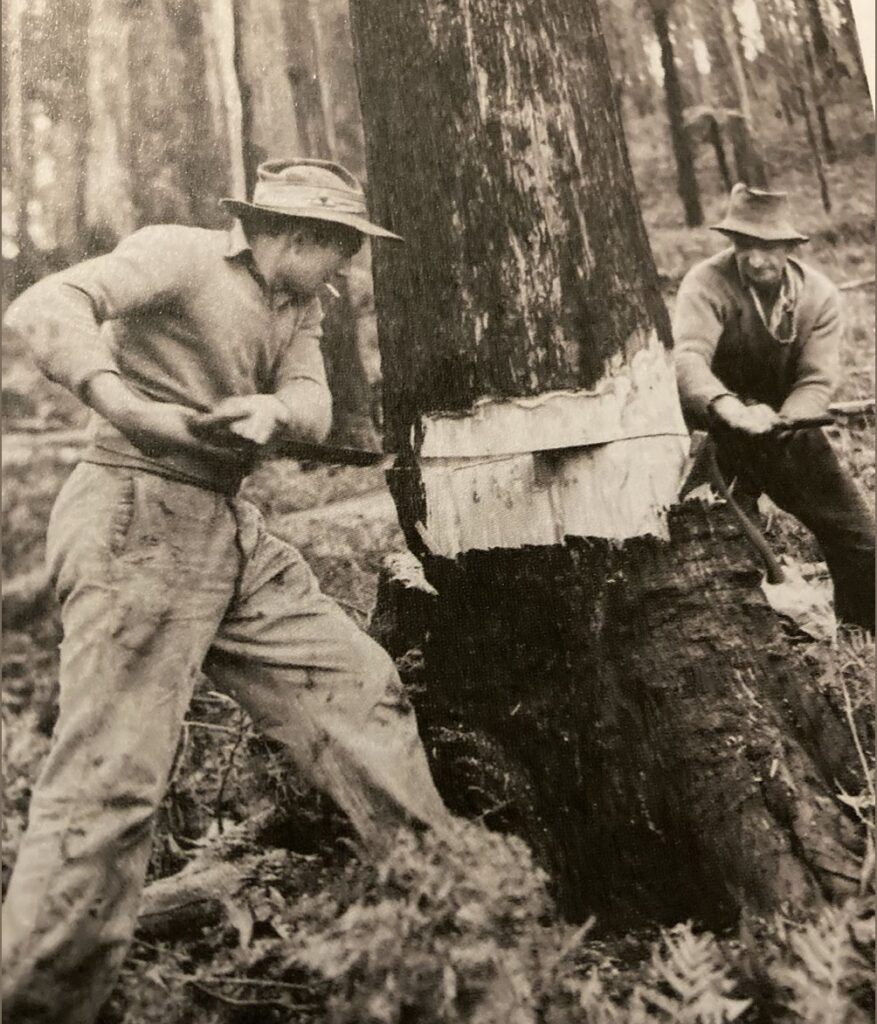
On three, the first racing axe blade bites into a timber round.
As the count rolls on, more axes swing into motion, creating a steady chorus of thud-thud, with woodchips flying through the air.
A few minutes later, a timber round, now resembling a neatly hewed apple core, snaps and falls to the ground.
Australia has a history of woodchopping and sawing competitions dating back to the nineteenth century. The first formal competitions started in the mountain ash or swamp gum forests of southern Tasmania, where the axemen developed the Tasmanian axe for cutting hardwood.
It is commonly believed that the sport of woodchopping originated in 1870 when Tasmanian Joseph Smith challenged Victorian Jack Biggs to cut a three-foot block for a wager of fifteen pounds. When Smith’s board began to sag, a gentleman moved in to take the weight on his shoulders, which gave victory to his champion. The report concludes with everyone celebrating with large pints of brown ale. A plaque in Ulverstone commemorates the event taking place in 1870. However, the wager took place in 1876. After the 1876 wager, Joseph Smith’s son donated a handsome trophy to remember his father’s event and achievement.
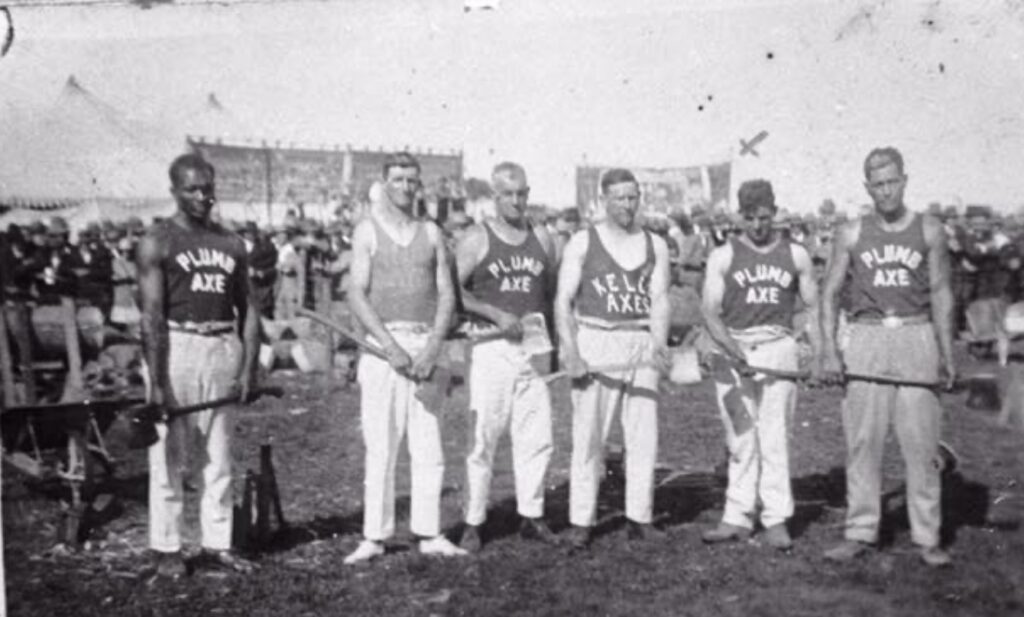
The first confirmed record of a chopping match was in 1872. Edward Murray of Surges Bay and Edward Owens of Port Esperance competed against each other. They held their contest in the forest, with Murray winning by cutting through his tree in 44 minutes. The chopping match featured in mainland newspapers and led to other events in the Port Esperance and Southport areas, quickly spreading around the state and the mainland.
The first open chopping match, involving more than two people, not with trees but logs dug into the ground, was held in May 1877 at Penguin’s inaugural Agricultural Show. It featured four competitors and was very popular. Its success saw neighbouring towns Latrobe and Ulverstone host similar events. From 1880 onwards, wood chopping became the central attraction if a Tasmanian town had a show.
In 1891, a group of axemen formed the United Australasian Axeman’s Association to formalise the sport of woodchopping and confirm its rules. Later that year, the Atkinson’s sale yards in Latrobe held the inaugural championships. Sixty-seven axemen competed in the woodchopping events. The winner was Tom Reeves of Barrington, who cut through a 2-foot standing block, 30 inches in diameter, in 6 mins 22.5 seconds. He was also a champion runner, sometimes combining both sports in one carnival.
There are four distinct types of competition.
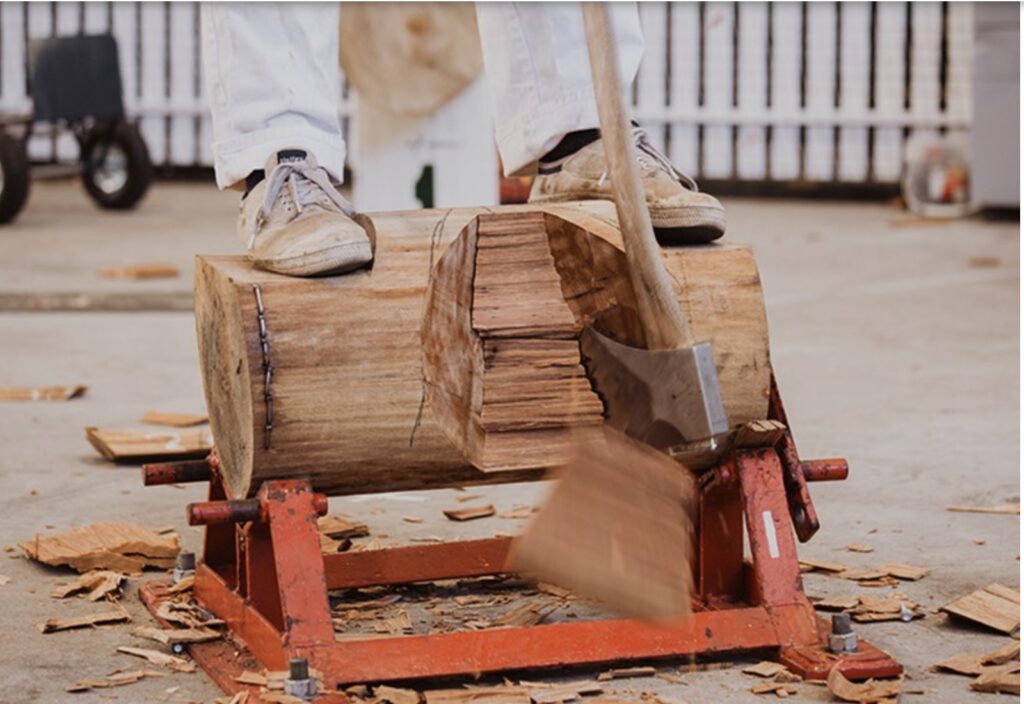
Underhand is considered easier to manage than the standing block. The log lies horizontally in a cradle and is fixed, or “dogged”, at one end so that when the log is severed, the free end falls away. Axemen place foot holes in the blocks to give them a safe flat platform to stand on.
The standing block takes longer to master and is generally more difficult than the underhand.
Logs are clamped vertically in a dummy, and the scarf is cut from each side until the block is severed. A high degree of skill is required, where technique usually trumps brute strength.
The tree felling is the most spectacular event in the sport and is the most difficult and demanding. It requires stamina as well as skill. The object is to climb the tree pole by cutting board holes and placing tree boards in the notches to ascend the tree in a spiral fashion.
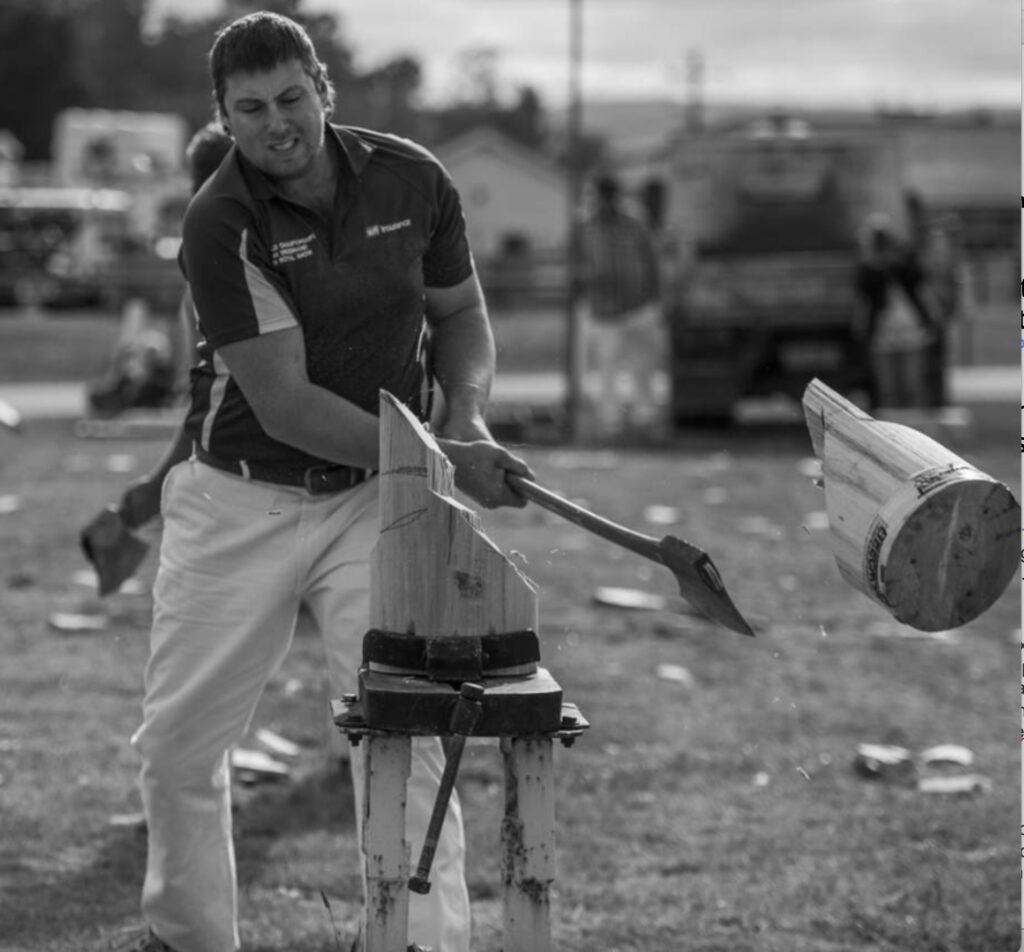
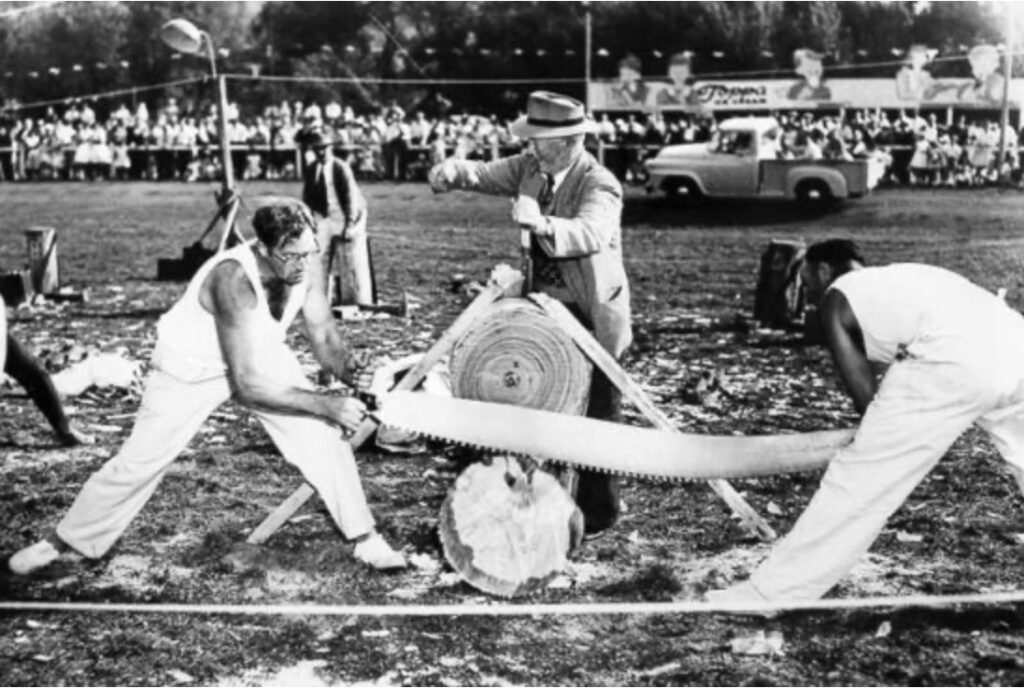
While balancing on the top board, the axeman cuts the block halfway through and then descends, bringing the same boards down. The process is repeated up the reverse side of the tree and concludes when the block is severed in half.
The sawing event can be single or double-handed. Single saw or buck is often considered the hardest discipline in woodchopping. The competitor pulls and pushes a razor-sharp saw specifically designed for the event.
The saws vary in length from five foot six inches to six foot four inches. The double saw event consists of two people pulling and pushing a saw to cut a log. It is far faster than the single saw event as there are two people using the saw.
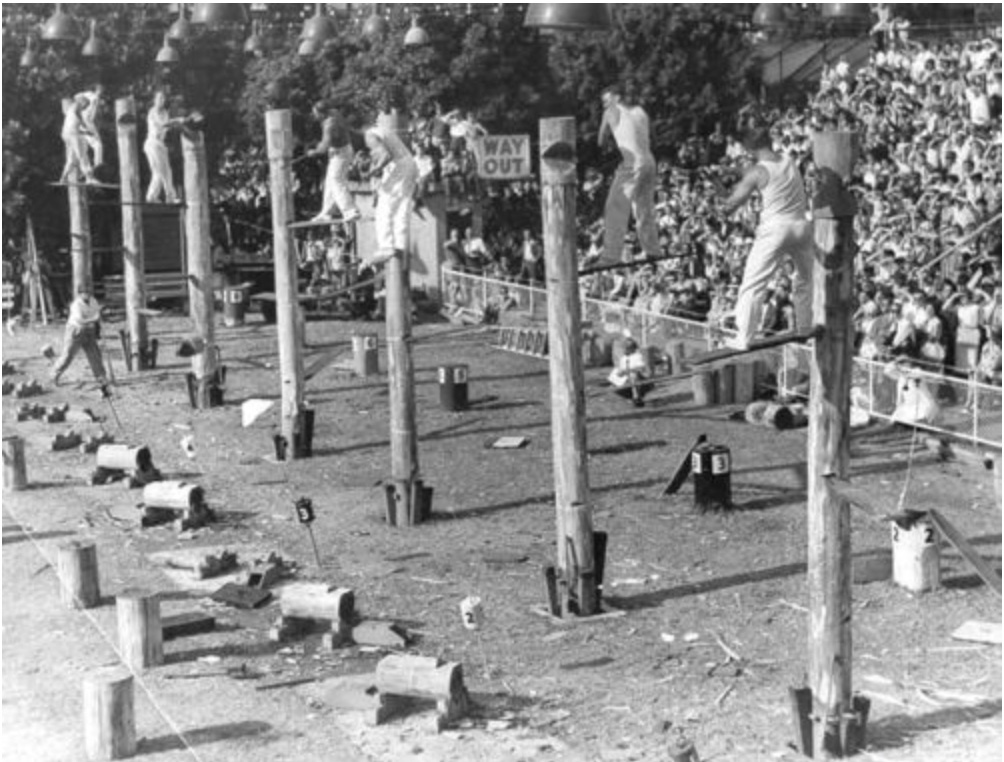
The 1970 world championships were held in Latrobe. It was promoted as the centenary event, attracting entries from all over Australia, the USA, Canada and New Zealand. The overall champion was George Foster from Ross in the Tasmanian Midlands, who won the Champion of Champions trophy. Despite his bulk, he was one of the fastest underhand cutters in the world. After smashing his way through the heats, he took out the 35 centimetre world underhand in record time in the final. George and his 13-year-old son, David, won the World 600 millimetre double-handed sawing championship. The win was their first of eleven consecutive years at that event.
Tasmania has produced probably the greatest axemen on earth and claims the greatest chopping family in the world. There are seven Youd brothers, with six of them axemen who all starred at local carnivals. The patriarch, Albert, bush-born and bred, was a well-known axeman. He brought up his sons in Deloraine the same way.
Merv, Doug, Rex and Ray all won world championships. Ray excelled at tree felling and between 1954 and the late 1960s, thrilling crowds with his whirlwind ascents of the trees. He was always the backmarker, sometimes starting as much as 80 seconds behind the scratch man.
Doug’s 37-year career began in 1945 becoming the world champion at the standing block, the youngest Tasmanian to do so. He won 22 world championships, 15 world tree-felling championships, four world standing and countless “hard-hitting” titles. Doug took over the tree felling crown in the early 1960s from Ray.
Doug won the Champions of Champion trophy in 1974 in Ulverstone. Unfortunately, he missed the 1970 centenary Championships due to an accident. That year he was sawing through a tree with a chainsaw when it kicked out of the back and jumped off the ground into his left side, nearly cutting him in two. Doctors inserted 250 internal and 50 external stitches into his body. Ten days later, he watched the championships, but he was back in action two months later.
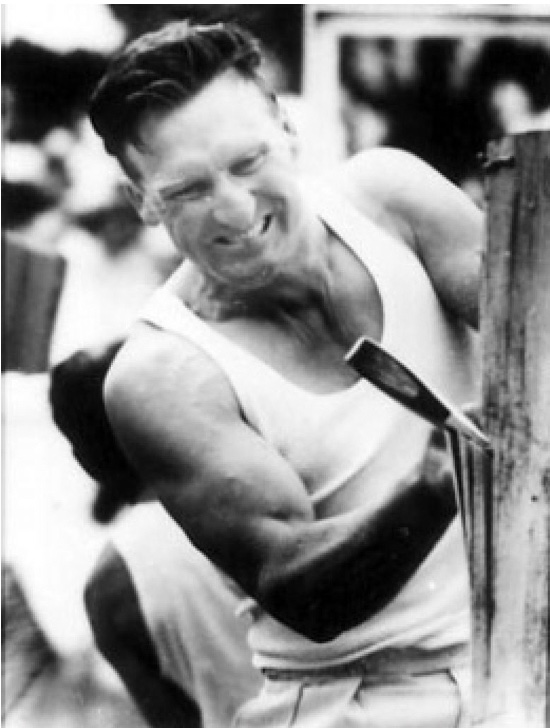
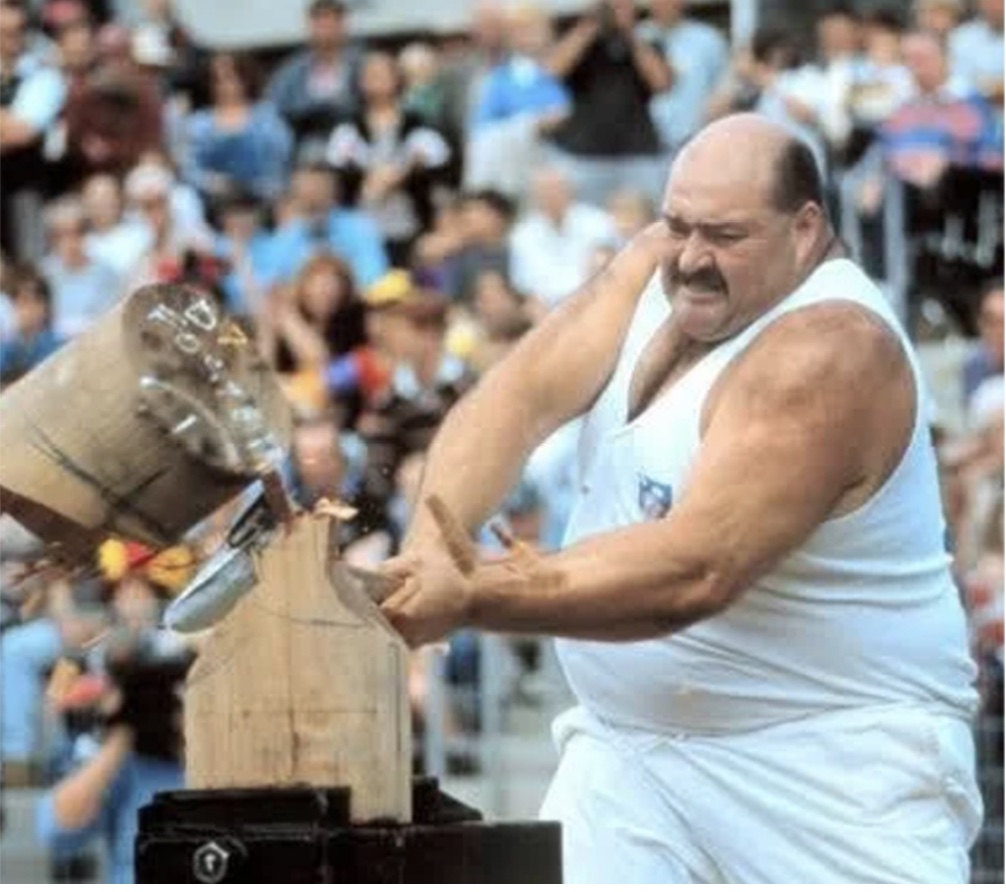
David Foster is sporting royalty when it comes to woodchopping. He is the first person in sporting history to have won over one thousand championships and is the most successful axeman in history. His record includes 182 world titles and 179 national titles. He held the World Woodchopping Championship title for 21 consecutive years. He is the only axeman to be inducted into the Sport Australia Hall of Fame and is a massive supporter of the timber industry.
I had the pleasure of meeting him on several occasions in Tasmania. He is a huge man. I will never forget him standing beside my wife at the Australian Axeman’s Hall of Fame in Latrobe. With all of her 55 kilogram and 5-foot-five frame, she was completely overshadowed by his 150 kilogram bulk and 6-foot 6-inch man-mountain frame.
Many very fine axemen, however, are not overly big physically. They can often compete successfully against men much bigger than themselves by cutting the log more precisely, with fewer hits and better technique and timing.
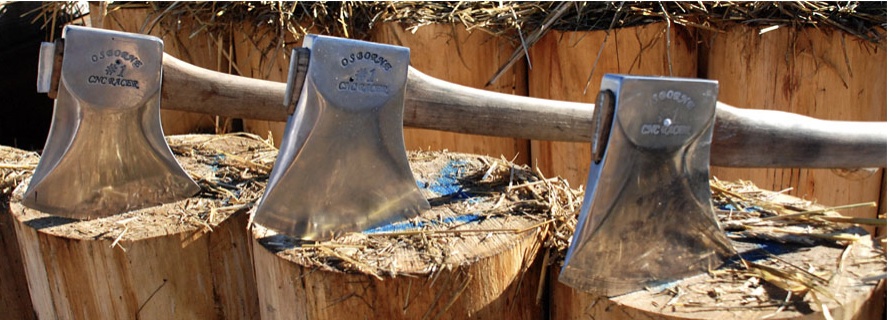
Modern-day racing axes are very specialised instruments. In the 1940s, Keech castings revolutionised the process of manufacturing racing axes by casting a special mix of steel in sand moulds. They are not available from any standard hardware shop or retailer. The axes usually weigh around 2.5–3 kilograms and are about 150–185 millimetres wide at the blade. They are fitted with high-quality American Hickory handles. Several brands are available such as Keesteel, Langdon, Osborne Racers, Proaxe, Valley Forge and Tuatahi (NZ).
The Australian Axeman’s Hall of Fame was built via a federal government grant in Latrobe in 1999. This was the location of the world’s first official international woodchopping championship in 1891.
It was one of the best-known tourist sites in the area. Unfortunately, the site quickly became tired and outdated. The local council took over managing the building from the Australian Axeman’s Association (AAA) and leased it to a Thai restaurant operator. That proved a failure when visitors were disappointed to find a room with the memorabilia buried out the back was closed.
However, after months of working with the AAA, the displays have been modernised and improved using old and new technology. The refurbished museum was opened in April 2021. The Hall of Fame is dedicated to the achievements of Australian axemen. They are amazing physical athletes who display strength, balance, agility and skills.
I was very fortunate to have worked with men who showed those qualities and displayed them not only at work but also on the Show circuit in pursuit of a little pocket money and local recognition. For some, it brought fame and a little wealth, but for most it was their hobby.
Have at look at this great video of current female woodchopper Amanda “Kiss My Axe” Beams and her family maintaining the Tasmanian woodchopping tradition.
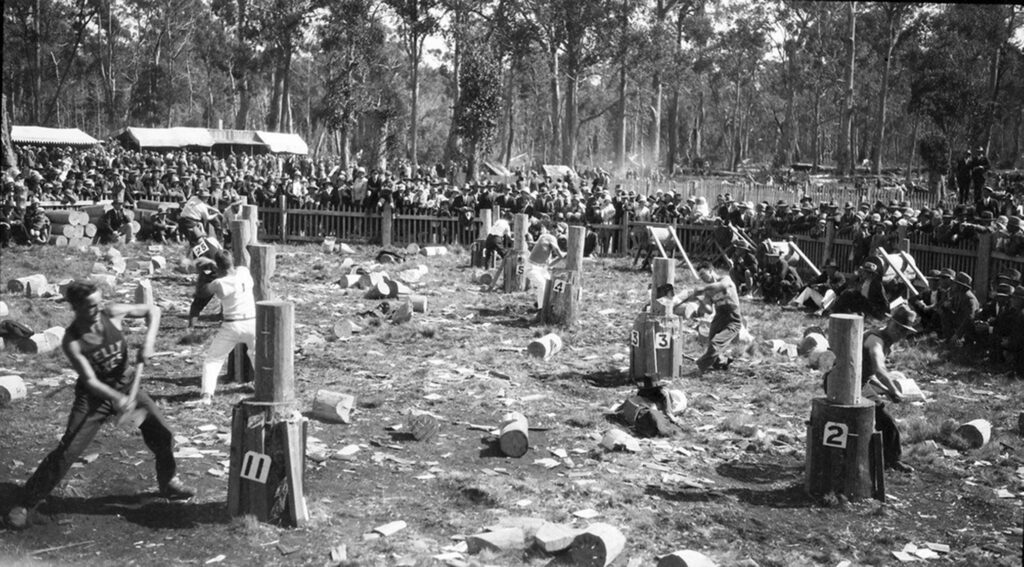
Oh dear. Tasmanian world champion axeman is David FOSTER. Not Forster. Name needs correction.
Thank you Jude for picking that up. Duly corrected.
Thanks Robert.
Brought back memories of my friend and colleague, Tom Brittain, who was an amateur wood-chopper here in WA.
Frank
Frank, his son Todd told many stories about his father and woodchopping on the Forestry Western Australia Facebook page, in response to my story.
One was when he chopped off his big toe in the underhand at the Kanyana festival in Mandurah in 1967.
They put the toe in a foil pie tin, iced it, then took it to the Mandurah hospital and sewed it back on. Todd said it always looked a bit strange after that!
The Amanda Beams video more or less ‘says it all’. GREAT!
I’ve also met David Foster on many occasions and concur with everything you write about him. His sense of humour was ever-present.
Just being in the same room with him made everyone feel happy.
One more thing, Robert:
The main character in my novel – Surviving is Dead Easy (published in 2020) – is Ned Youd, who is a beef cattle farmer ‘near Mole Creek’. The novel is set in year 2150, but there is NO science fiction in it.
Its message is “The Future is in the Past”. Ned says; “I’m tall with a weight to match and I’ve always allowed my bulk to do my talking.”